Birding in Costa Rica with an Expert guide
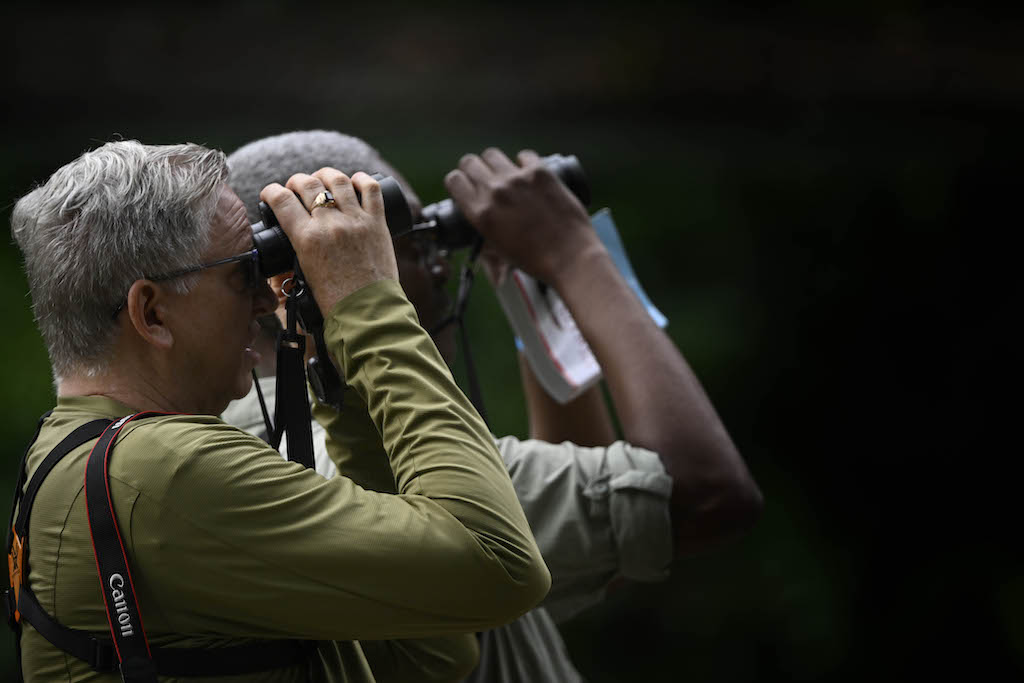
A perfect opportunity for avid birders, wildlife photographers, and nature lovers.
Birding is best done in small groups with a professional, certified guide. Birding tours can be done during the day or at night and can be focused on bird photography or seeking out lifers.
Both birds and birders flock to Costa Rica. The country has 12 of the plant’s 18 life zones and many microclimates, creating a birding paradise. In addition, the country has primary and secondary forests, transitional dry forests, and cloud forests. Each of these biogeographical regions has unique, thriving habitats.
Thanks to conservation efforts and natural ecosystems, there is an extensive list of notable tropical bird species and migratory species to spot in Costa Rica year-round. Costa Rica is a bird lover’s paradise. Costa Rica is home to more than 932 species, including 100 endemics in the area.
Some of the best birding in Costa Rica is done in the early morning and dusk. Therefore, going at these times maximizes the number of birds you’ll encounter.
Popular locations for birding in Costa Rica include Arenal, Manuel Antonio, the Central Valley, Monteverde, Talamanca Highlands, Caribbean foothills, Sarapiqui, Turrialba, Guanacaste, and the Osa Peninsula.
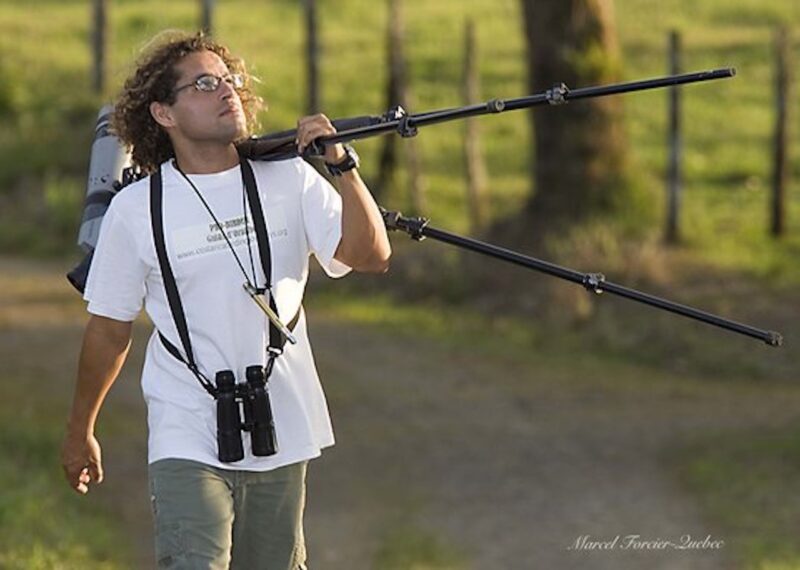
Why you should pick a professional birder guide for your tours?
Birding is popular in Costa Rica because the country’s home to over 932 species. Going on a tour specifically to see find and see birds with a guide is a dream come true for those who want to see the many birds of Costa Rica.
Some experts estimate that while you might see about ten species of birds on a typical nature tour, on a specific birding tour with a trained guide, you can see about 50. Some avid birder groups have even reported seeing 100-150 species in a single day.
Some good spots for birding in Costa Rica.
Arenal
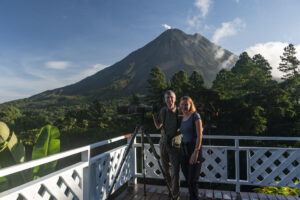
In the Arenal area, it is not unusual to see a Keel-Billed Toucan, a Montezuma Oropendola, or a Laughing Falcon, to name just a few.
You might tour the Arenal Volcano National Park, the rainforest, around the Lake, the El Silencio Nature Reserve, or Arenal Observatory Lodge, a Private Reserve. Your guide will know which spot is best depending on the season and will take you to an area with a significant concentration of birdlife waiting for you. Your guide will be a wealth of knowledge, and with eagle eyes, you won’t be disappointed by the variety of birds you will spot. The Arenal Volcano area and the surrounding northern lowlands offer some of the best birding locations for birders and bird photographers. In addition, quality foothill rainforests are accessible at several sites, and there are bird-watching trails very close to the town of La Fortuna.
Monteverde
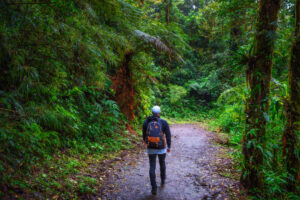
Some of the best birding happens in Monteverde. A beautiful town situated on top of a mountain range, 6000 feet above sea level. The continental divide and humid winds from the Caribbean arrive year-round, creating a cloud forest. Birdwatching in the cloud forest is truly something special.
Monteverde is home to 50% of Costa Rica’s flora and fauna. Five hundred bird species call it home. In addition, it’s a top birding destination, known internationally.
Many birders go to Monteverde just to see the rare Resplendent Quetzal. Quetzals are spotted most frequently from April to July.
The area is also known for having multiple hummingbird gardens, and the giant hummingbird in the country is the Violet Sabrewing.
There are 140,000 acres of private reserves in Monteverde. Some places to birdwatch in Monteverde include the Monteverde Cloud Forest Preserve, Curi Cancha, the Children’s Eternal Rainforest, and the Santa Elena Reserve.
With the help of a trained eye, while birding in Monteverde, you might see the Black and Yellow Silky Flycatcher, Chiriqui Quail Dove, Three-Wattled Bellbird, Green Crowned Brilliant Hummingbird, Black-breasted Wood-Quail, Emerald Toucanet, the Zeledon’s Antbird, Ochre Breasted Antpitta, Bare-necked Umbrellabird, Green Hermit, Buff Fronted Quail Dove, Keel-Bellied Trogon, Blue-throated Goldentail, Orange-Bellied Trogon, Black Guan, Golden-Browed Chlorophonia, Black-breasted Wood-Quail, and the Magenta-Throated Woodstar.
Birding in Monteverde is not complete until you see the Three-Wattled Bellbird, which has three beard-like tendrils hanging around its beak. Easy to recognize due to its bell-like call.
Guanacaste
![]()
Birding in Guanacaste is interesting because marshlands, mangroves, and forests are close. In addition, it’s a tropical dry forest, the largest conserved area of tropical dry forest in all of Central America. It’s also the southernmost place to find MesoAmerican bird species.
Along the Pacific coastline, coastal birding is a breeze. You’ll see shorebirds and aquatic species.
Bird Island protects nesting grounds for marine birds like Pelicans and Frigates. In addition, it’s one of the best spots for birdwatching in Guanacaste.
Popular months to birdwatch in Guanacaste are January, February, July, and August. Expect to see some of the following: the Jabiru Stork, Limpkin, Bay-Winged Hawk, Spot Breasted Oriole, Elegant Trogon, Black Crowned Night Herons, Streak Backed Orioles, Lesser Ground-Cuckoo, Rufous-Necked Wood-Rail, Mangrove Hummingbird, Crested Bobwhite, Pacific Screech-Owl, Lattice-Tailed Trogon, Keel-Billed Motmot, Black Faced Solitaire, Branded Wren, Royal Fly Catcher, Thicket Tinamou, Red-Crowned Ant Tanager, Stub Tailed Spadebill, Ruddy Woodcreeper, Montezuma Oropendola, White-fronted Parrot, Spectacled Owl, Harris Hawk, and the Scissor-Tailed Flycatcher.
Carara National Park
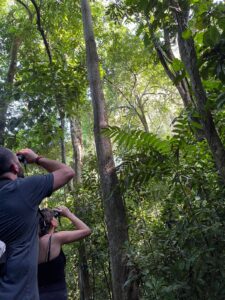
Exploring Carara National Park is relatively easy. Most of the trails are flat or nearly flat, so access and navigation is suitable for most levels of physical ability.
Visitors can choose a single trail and spend an hour walking through the park, or for those looking for a higher level of exploration, a full day can be spent trekking through the park.
Universal Loop is the main trail from the ranger station. It is 1.2 km (¾ of a mile) and it loops through shady forest and thick undergrowth. The trail is flat and paved, so even visitors in wheelchairs can manage this trail. There are benches to rest or take in the sights and sounds of the forest, restrooms, and signs that give information about the flora and fauna. This trail is great for general tourists or birders looking for a quick visit.
About halfway down the Universal Loop trail, visitors will find the trailhead of the Quebrada Bonita Trail (1.5 km / 1 mile). This trail is not paved, this is a hiking trail with a more narrow path, tree roots, and some short up and downs. This is a great trail for anyone interested in plants and trees as many of the trees along this trail are over 100 years old.
During a birding tour en Carara, you can expect to see, birds like Yellow-bellied Flycatcher, Chestnut-sided Warbler, Yellow-throated Vireo, Ruddy Quail-dove, Rufous-and-white Wren, Northern Bentbill, Black-hooded Antshrike, Dusky Antbird, Brown-hooded Parrot, Scarlet Macaw, Plain Xenops, Wedge-billed Woodcreeper, Masked Tityra, Northern Barred Woodcreeper, Dot-winged Antwren, Orange-collared Manakin, Baird’s Trogon, Common and Slate-headed Tody-flycatcher, Purple-crowned Fairy, Long-tailed and Little or Stripe-throated(same species)Hermit, Turkey, Black and King Vulture, Streaked Flycatcher, Cocoa or Buff-throated Woodcreeper, Rufous-breasted Wren, Black-bellied Wren, Black-throated Trogon, Violaceous Trogon, Black-headed Trogon, Lineated Woodpecker, Riverside Wren, Cherrie’s Tanager, Red-legged Honeycreeper, Golden-hooded, Summer and Gray-headed Tanager, White-collared Swift, Boat-billed Flycatcher and many others.
Osa Peninsula
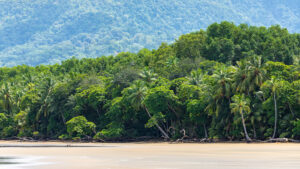
Birding on the Osa Peninsula allows you to see mangrove species and those from the primary rainforest in one day.
This lowland rainforest is an undisturbed natural wilderness full of unspoiled land. The remote area is home to some of the last remaining old-growth rainforests. It boasts 400 species of birds. Some are the Rufous Mourner, Black-faced Antthrush, Marbled Wood-Quail, Turquoise Cotinga, Mangrove Hummingbird, Riverside Wren, Spot-Crowned Euphonia, White-Tipped Sicklebill, and Black-and-White Hawk-Eagle.
The pristine Southern Pacific coastlines call out to birds. At least 60 species spend the winter on the peninsula, including Wood Thrush, Canada Warbler, and Wilson’s Plover.
From December to February, the dry season is preferred for the best birding on the Osa Peninsula.
Central Valley
Between the coasts, rainforests, and cloud forests of Costa Rica sits the Central Valley. The climate from December through September is ideal for checking off some of the birds you most want to see from your list.
Let’s talk about the different species types you can watch out for—starting with the Fiery-Throated Hummingbird, Yellow-Thighed Finch, Golden Browed Chlorophonia, and Mountain Robin. Next up, we have the Slaty Flowerpiercer, Maroon Chested Ground-Dove, Ornate Hawk-Eagle, White-fronted Nunbird, and the beautiful Solitary Eagle. Last but not least, the Clay-colored Thrush, Northern Crested Caracara, Crimson-Fronted Parakeet, Ferruginous Pygmy-Owl, and Laughing Falcon
Additionally, the region is home to 25 hummingbirds and 365 bird species in total. You might birdwatch as you go hiking or from a rainforest aerial tram for a bird’s eye view.
In Nature Group Costa Rica, we have the guides, come join and let’s have a wonderful birding time.
Author: Daniel Montiel – Nature Group Costa Rica.
References: The birds of Costa Rica by Garrigues and Dean
